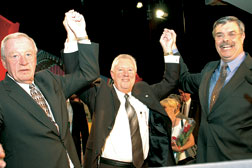 |
| Wrenching. Construction labor shortages will make nontraditional sources more important. (Photo by Michael Goodman for ENR) |
The intersection of 16th and I Streets in Washington, D.C., couldn’t be a better icon of the complex and ironic state of construction labor relations these days. On one side of the street, the gold symbol of the Laborers’ International Union of North America shines brightly. On the other, big black letters announce the headquarters of the AFL-CIO. Once inextricably linked, these two organizations now are estranged.
A few blocks away are symbols of other entities tied to the future of the construction craft work force—the White House, the “K Street” big business lobby corridor and the Washington office of Bechtel Corp. The San Francisco firm, which works both union and nonunion, is one of many contractors watching the industry’s changing labor dynamics. And “beyond the Beltway,” local construction participants cope with their own labor and market pressures and are forging bonds that may or may not reflect the view from 16th Street.
The decision this year by two key construction unions, the laborers and the operating engineers, to officially disaffiliate from the AFL-CIO's Building and Construction Trades Dept. ratcheted up long-simmering union discord with the umbrella organizations. The operating engineers remain members of the AFL-CIO, but the teamsters’ union bolted both organizations a year ago, aligning with the dissident Change-to-Win union coalition. The carpenters had left the AFL-CIO four years before.
The operating engineers’ and laborers’ departure, along with a total of 1.1 million members, was announced last February, with angry words and rhetoric flying between leaders of the individual unions and BCTD over significant market share loss, ineffective leadership and out-of-date jurisdictional rules (ENR 2/27 p. 12). The two unions announced formation of a new union organization called the National Construction Alliance (NCA), but details remained sketchy as to whether other construction unions would join them in leaving the AFL-CIO, what the new group’s mission would be and the effect on local unions.
Laborers’ President Terrence O’ Sullivan says NCA has sprung to life since June 1, but with only his union, the operating engineers and carpenters officially on board. “We announced last September that it wasn’t a question of ‘if,’ but ‘when,’” he adds. “It was in the best interest of our organization to disaffiliate from both BCTD and the AFL-CIO.”
Even with the split, there still are links with other unions, such as with the bricklayers and ironworkers on heavy-highway projects. The laborers’ union still even supports the AFL-CIO in its political agenda, particularly as the November mid-term elections loom. “We’ve always said that where the AFL-CIO adds value, we’ll work with it,” says O’Sullivan.
The events at the national level also seem to be having little impact on local labor relations. “A lot of our unions still belong to local building trade councils,” says O’Sullivan. “If it works well in New York City or Detroit, areas with big market share, then why alter the structure?” Even so, with the open shop making new inroads in urban markets (see related stories, right), some local NCA unions see more organizing flexibility.
Fading Fears
But early fears among contractors and owners that the NCA split would elevate jobsite disharmony and scuttle joint efforts to improve market share seem to have faded for now. Kansas City-based Burns & McDonnell, program manager for a $1-billion power upgrade in Connecticut, worried whether it could sign a project-wide labor agreement after NCA was announced. The project will require a peak work force of 650 before it wraps in 2009. “It got sticky when the unions broke from the building trades,” says J. Brett Williams, Burns & McDonnell local program manager. “It was not as automatic to sign an agreement.” A jurisdictional issue arose with electricians over scope of site work, “and there was heated discussion over who would do what,” he says. But Williams credits local managers of the International Brotherhood of Electrical Workers for compromising. “We considered merit shop, although we didn’t want to,” he says.
“So far, the unions are cooperating at the jobsite level as before. Issues still arise, but they are being dealt with,” says a member of the Construction Users Round Table, an owners’ group that is pushing for better labor-management relations. Adds Ray Poupore, a former heavy-highway union official who now is NCA executive vice president: “We’re going down two separate tracks now, but we have the same goal.”
 |
| New Recruits? Day Laborers’ Alvarado (left) and AFL-CIO chief Sweeney announced “partnership” on Aug. 9. (Photo by Tim Boyle/Getty Images) |
That goal is to elevate construction union membership in the U.S., which has fallen from 40% in 1973 to 13% last year, says O’Sullivan. He cites labor’s antiquated process to resolve jurisdictional disputes as a deterrent to growth, something BCTD has not targeted. “In fairness, they’ve made some progress, it’s just not enough,” says O’Sullivan. NCA officials promise a “21st Century” approach where such issues are minimized.
Contractors are watching NCA with interest and optimism. “It’s refreshing to hear union leadership who want to form relationships with contractors to give us their best people and competitive wages,” says Garry Flowers, group executive for global industrial relations at Fluor Corp., Dallas, which also works nonunion. “It’s a whole new concept.” But he also credits BCTD efforts to work with contractors. “We need all the unions,” he says. “We’d have a difficult time doing all the work with just this new alliance.”
 |
| Momentum. Incumbent Ironworkers’ union President Joe Hunt (center) easily won re-election, but trade’s road ahead will be tougher. (Photo courtesy of Iron Workers Union) |
Some say the three unions’ departure may not be permanent. “It is unfortunate, but I look at it as a separation, not a divorce,” says Michael Callanan, a top BCTD and IBEW training official.
Some see NCA as a protest against BCTD President Edward C. Sulllivan. “This is a political thing about the way the building trades are being run and Ed Sullivan’s leadership,” says ironworkers’ union President Joe Hunt. “Hopefully as time passes, with cooler heads, we can bring this thing back together.”
 |
| McGarvey |
BCTD Secretary-Treasurer Sean McGarvey won’t elaborate on department restructuring or efforts to woo back the unions. “I am unaware of any conversation of further changes in the department,” he says. McGarvey prefers to point to successes, including a productivity study with CURT focusing on worker attitudes and a new union employee drug screening program that will avoid duplicative tests. “This will be a tremendous cost savings to contractors,” he says.
McGarvey also points to enhancements to union training and apprenticeship programs. He notes efforts by the plumbers’ and pipefitters’ union to expedite worker training by teaching basic welding techniques in the first six months, instead of the third year. “It takes years to become proficient, but you can still teach the skill,” says McGarvey.
Taking a Toll
But the union departures have taken a toll on BCTD finances, eliminating more than $3 million a year in revenue. McGarvey says the department has pared overhead, cut staff, and won a 7¢-per-month per-capita dues increase as of July 1. It is BCTD’s first per-capita hike since 1992, says McGarvey. “By this time next year, our finances will be as strong as they’ve been in 15 years,” he predicts.
Fluor’s Flowers believes that building trade upheavals will settle once the current round of union elections are over. At least five major trades will have held conventions by later this month. Incumbent general presidents have so far stayed on.
Some didn’t pull any punches. “A union willing to accept the status quo is a union doomed to failure,” Hunt told ironworker convention delegates last month. “We organize or we die.” Delegates voted to increase funding for organizing by 50%. The union is eyeing new niches such as reinforcing steel. Surveys had shown...
 Related Links:
Related Links: 

